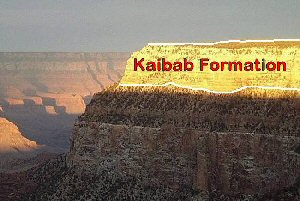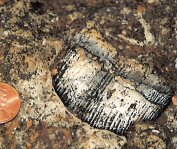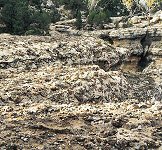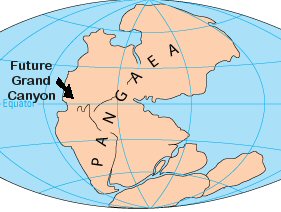Return to Canyon Dave Tour Pages
or the Nature and Geology Pages
*********************************************
List of Grand Canyon Rock Layers
What is Grand Canyon Stratigraphy?
Kaibab Formation
Toroweap Formation
Coconino Sandstone
Hermit Formation
Supai Group
Redwall Limestone
Tonto Group
Muav Limestone
Bright Angel Shale
Tapeats Sandstone
Vishnu Complex
Kaibab Formation
Permian Period, 270 Million Years Old, 350 Feet Thick.
Light gray to tan
cliff at the canyon rim.
 The Kaibab Formation was named after the flat Kaibab
Plateau that lies at 7,000 to 8,200 feet above sea level. Kaibab is a Southern Paiute Indian word meaning “mountain lying
down.” The Kaibab Formation is composed of sedimentary rocks: limestone, dolomite,
sandstone, and chert, deposited under a shallow inland sea.
The Kaibab Formation was named after the flat Kaibab
Plateau that lies at 7,000 to 8,200 feet above sea level. Kaibab is a Southern Paiute Indian word meaning “mountain lying
down.” The Kaibab Formation is composed of sedimentary rocks: limestone, dolomite,
sandstone, and chert, deposited under a shallow inland sea.
Some of the other Grand Canyon layers were terrestrial,
deposited on land. But all were deposited on a flat landscape near
sea level. Much
later, geological processes raised the Grand Canyon area to its present
altitude of 7,000 feet at the South Rim and
8,200 feet on the North Rim.
 Among the bottom-dwelling or "benthic" creatures
of the sea, such as clams, corals, and snails, the shells are most commonly made of the mineral
calcium carbonate (CaCO3). After many years,
waves and currents break down or dissolve most such shells.
Among the bottom-dwelling or "benthic" creatures
of the sea, such as clams, corals, and snails, the shells are most commonly made of the mineral
calcium carbonate (CaCO3). After many years,
waves and currents break down or dissolve most such shells.
The remains of the shells will eventually
be deposited to form an ocean-bottom mud known as "ooze". Over the milennia, the ooze hardens
to form the rock types called limestone and dolomite. A few surviving shells
may be preserved as fossils, but most become crushed or dissolved and are
no longer recognizable.
Most
limestone is gray in color. The Kaibab Formation at the South Rim is made of
limestone, but the limestone here contains much sand. This is because the
sandy shoreline of the Kaibab inland sea was usually less than 20 miles east of Grand Canyon,
and beach sand washed into the ooze while it was forming. Because of
the sand, the Kaibab Formation shows a sandy tan color.
 Chert is a minor rock constituent of the Kaibab Formation. Chert is a hard, brittle rock made of silica
(SiO2) that often forms as lumps or “nodules” within limestone beds.
Chert can be almost any color--gray, white, tan, red, green, and even black. Chert has been useful throughout the human
ages: it was the chief tool-making
material of ancient people worldwide. Most of the arrowheads you have seen
were probably made of chert.
Chert is a minor rock constituent of the Kaibab Formation. Chert is a hard, brittle rock made of silica
(SiO2) that often forms as lumps or “nodules” within limestone beds.
Chert can be almost any color--gray, white, tan, red, green, and even black. Chert has been useful throughout the human
ages: it was the chief tool-making
material of ancient people worldwide. Most of the arrowheads you have seen
were probably made of chert.
The brown spheres and lumps of chert in the Kaibab
Formation are mostly made from the silicious cherty
skeletons of ancient sponges called Actinocoelia. The brown dots in
this photo are chert nodules containing Actinocoelia.
 This chert nodule contains a white sponge fossil, Actinocoelia. Chert is very hard, so the sturdy
chert in the
Kaibab Formation causes this layer to resist erosion. In a sense, the lowly
sponge protected the Grand Canyon, because this top canyon layer shields all the
layers beneath.
This chert nodule contains a white sponge fossil, Actinocoelia. Chert is very hard, so the sturdy
chert in the
Kaibab Formation causes this layer to resist erosion. In a sense, the lowly
sponge protected the Grand Canyon, because this top canyon layer shields all the
layers beneath.
This little story pretends that people were alive when the Kaibab Formation was laid down. But it was long, long before people. It was 270 million years ago. The story's purpose is to immerse ourselves in the time period--to imagine that we were a tribe living in the environment of the time. Why do this? Because to imagine these ancient times--to even try--is to better understand the majesty of time's march.
Our Tribe in Kaibab Time
Here at the future Grand Canyon, the sea has encroached from the west and the shoreline is in the east, so at the moment we are swimming in 100 feet of salt water. There are sharks and bony fish in these waters. Invertebrates and seaweed thrive on the bottom.
 Everything has that salty, fishy, tide pool smell. The sea floor is thick with sponges: we collect them for trade
in Pangaea, our world continent. On our world map to the right, perhaps you can make out the shapes of some continents that
will one day appear. But our people know nothing of this.
Everything has that salty, fishy, tide pool smell. The sea floor is thick with sponges: we collect them for trade
in Pangaea, our world continent. On our world map to the right, perhaps you can make out the shapes of some continents that
will one day appear. But our people know nothing of this.
The shifting shorelines of the Kaibab Sea will come and go, intermittently covering the Grand Canyon area.
But from our tribe's puny human perspective, the shoreline will be just as it is "now", for ever and ever. A thousand years
is nothing to the ages of the earth, but we have myths that our ancestors lived here
then. In another thousand years, our descendants will collect their sponges. It will always be like this.